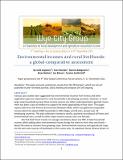| dc.contributor.author | Angelsen Arild | en |
| dc.contributor.author | Wunder, S. | en |
| dc.contributor.author | Babigumira, R. | en |
| dc.contributor.author | Belcher, B. | en |
| dc.contributor.author | B”rner, J. | en |
| dc.contributor.author | Smith-Hall, C. | en |
| dc.date.accessioned | 2016-06-23T15:04:03Z | |
| dc.date.available | 2016-06-23T15:04:03Z | |
| dc.date.issued | 2011 | en |
| dc.identifier.citation | Angelsen, A., Wunder, S., Babigumira, R., Belcher, B., Börner, J. and Smith-Hall, C. (2011) Environmental incomes and rural livelihoods: a global-comparative assessment. Paper presented at the 4th Wye Global Conference, Rio de Janeiro, 9th -11th November 2011. | en |
| dc.identifier.uri | https://opendocs.ids.ac.uk/opendocs/handle/20.500.12413/11904 | |
| dc.description.abstract | Various case studies have suggested that environmental incomes from forests and other
vegetation types are important for rural households in developing countries. However, in most
large-scale household surveys these income sources are either underreported or ignored, hence
there has been a lack of evidence to support the wider applicability of that claim. This paper
reports data from the Poverty Environment Network (PEN), which has gathered comparable
income data from about 8,000 households in 360 villages and 58 sites, spread over 24
developing countries. The data collection involved a careful, quarterly recording of all forest and
environmental uses, as well as other major income sources over one full year.
We find that forest income on average constitutes about one fifth of total household
income, while adding other environmental income brings the share to more than one fourth –
about the same as incomes from growing crops. Environmental resources and agricultural crops
are the two main sources of livelihoods in the survey sites. As expected, forest reliance (share of forest income in total household income) is higher for the poorer income quintiles, but the
differences are less pronounced than what was found in most previous studies. We also find
that safety net and seasonal gap-filling functions may be less important that often assumed.
Ignoring environmental incomes in income surveys and in rural development planning
would in quantitative terms amount to ignoring that farmers grow crops. Agricultural area
expansion into forests and other vegetation types may well come to increase household
incomes, but corresponding income losses from losing forest cover and forest degradation could
be larger than previously assumed. Depriving poor people of access to forest product extraction,
for instance through highly exclusionary conservation policies, could jeopardize the livelihoods
of people depending on these resources. | en |
| dc.language.iso | en | en |
| dc.rights.uri | http://creativecommons.org/licenses/by-nc-nd/4.0/ | en |
| dc.title | Environmental incomes and rural livelihoods : a global-comparative assessment | en |
| dc.type | Conference paper | en |
| dc.identifier.externaluri | https://doi.org/10.35648/20.500.12413/11781/ii122 | |
| dc.identifier.ag | RES-167-25-0257, ES/E021816/1 | en |
| dc.identifier.doi | 10.35648/20.500.12413/11781/ii122 | |


